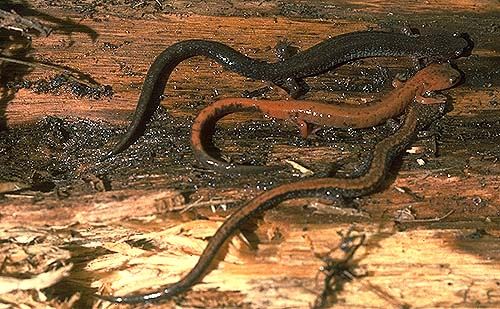Did you know that the red-backed salamander (Plethodon cinereus) comes in three different varieties? That means there are three main, distinct color patterns (called phases or morphs) that P. cinereus can exhibit (and an additional five or so anomalous morphs). So why do these differences exist? If one color morph helps P. cinereus avoid predators better or is more attractive to potential mates, shouldn’t that color morph win out and be all we see? Turns out evolution isn’t that simple...
The erythristic morph is perhaps the most interesting, and poorly researched. Most of us have never even heard of, let alone seen this all red morph of P. cinereus. I certainly hadn’t. Tilly et al. (1982) studied populations of erythristic red-backs in the Northeast U.S. Their study found that birds (in this study, captured wild blue jays) avoided eating the erythristic red-backs. Tilly et al. asserts that the all red erythristic P. cinereus enjoy an advantage because they look like the toxic red eft stage of the red-spotted newt (Notophthalmus viridenscens). Being an example of mimicry also helps explain why the erythristic morph is rarely seen. In order for a mimic to be successful, the tasty mimic must coexist with and be less abundant than the unpalatable model it mimics. Otherwise, predators will find tasty mimics more often than unpalatable models, and the advantage of looking toxic, and possibly even the advantage of being toxic, will be lost.
Around here we see mostly the red-backed morph. This familiar P. cinereus morph usually has a distinct red stripe down its back, though there can be A LOT of variation in the color and shade of the stripe. Multiple studies show that the red-back morph is the most common morph in the northern, cooler portions of its range. The further south, the more the proportion shifts towards the lead-back morph (almost all back with no stripe). One rather peculiar study conducted in Maryland used clay models of P. cinereus to determine if predation played a role in the proportion of red-back to lead-back morphs (Grant et al. 2018). In Maryland, the lead-back morph is much more common. By using clay models, the researchers were able to distinguish whether a predation attempt was from a mammal or bird from the marks left on the model. They found that birds in particular targeted the red-back models more than the lead-back models, suggesting that birds, which hunt primarily by sight, can more easily see and eat more of the red-back morph, leading to a greater proportion of the lead-back morph in the Maryland population. But if that’s true, why are there more red-back morphs further north? And if they are being targeted more, why is the red-back morph still around?
et al. 2018). In Maryland, the lead-back morph is much more common. By using clay models, the researchers were able to distinguish whether a predation attempt was from a mammal or bird from the marks left on the model. They found that birds in particular targeted the red-back models more than the lead-back models, suggesting that birds, which hunt primarily by sight, can more easily see and eat more of the red-back morph, leading to a greater proportion of the lead-back morph in the Maryland population. But if that’s true, why are there more red-back morphs further north? And if they are being targeted more, why is the red-back morph still around?
The three morphs of the Red-backed salamander photo by Nova Scotia Museum
The Maryland study lacks the consideration of a key component of the predator-prey evolutionary arms race—postautotomy tail movement. This is the fancy, scientific term for a particular predator-avoidance strategy shared by a number of salamanders and lizards where the end of the tail breaks off and starts wriggling around. The benefit is the predator becomes distracted by the wriggling tail and loses interest in the salamander, allowing the salamander to escape with its life. Don’t worry, the tail grows back. Surprisingly, the autotomized tails of the red-back morph wriggle around faster and for a longer period of time than those of the lead-back morph (Otaibi et al.). This could be due to an increase in predation pressure on the red-back morph. If that red stripe makes them easier to see and they get targeted more by predators, evolution could favor the adaptation of more movement of autotomized tails. But then why would the red-back morph exist at all? What’s the advantage to having that stripe?
We could continue down this rabbit hole chasing an answer to that question only to be met with another question, and another and another and another. The question as to why both the lead-back and red-back morphs exist has a very complex answer that isn’t fully understood yet. Diversity in habitat, differences in predation pressures, physiological differences, food availability, and complex genetic interactions are just a few ingredients that make up the answer. One possibility that I like to entertain is that we could be glimpsing a snapshot in time of the evolution of two or even three separate species of salamanders branching off of the one and very diverse red-backed salamander. One thing is for certain though: these little salamanders have a lot to teach us about evolution and selection.
Citations:
Grant, A. H., Ransom, T. S., & Liebgold, E. B. 2018. Differential survival and the effects of predation on a color polymorphic species, the red-backed salamander (Plethodon cinereus). Journal of Herpetology 52: 127-135.
Tilley, S. G., Lundrigan, B. G., & Brower, L. P. 1982. Erythrism and mimicry in the salamander Plethodon cinereus. Herpetologica 38:409–417.
Otaibi, B. W., Johnson, Q. K., & Cosentino, B. J. 2017. Postautotomy tail movement differs between colour morphs of the red-backed salamander (Plethodon cinereus). Amphibia-Reptilia, 38(3), 395–399.